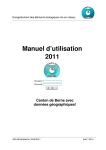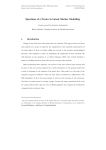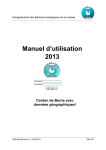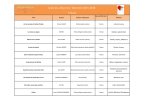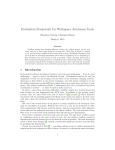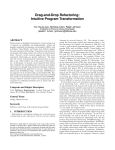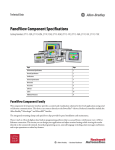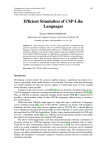Download Configuration Management for eXtreme Programming
Transcript
Configuration Management
for
eXtreme Programming
Ulf Asklund, Lars Bendix, Torbjörn Ekman
Department of Computer Science, Lund Institute of Technology, Sweden
{asklund,bendix,torbjorn}@cs.lth.se
Abstract
Extreme programming (XP) is a software development
method that prescribes the use of 12 different practices.
Four of these practices (collective code ownership,
continuous integration, small releases and refactoring)
can indeed be given good support by the use of simple
configuration management (CM) techniques. We report
on our experience in providing many groups of novice
developers with CM education, processes and tools to
support the four CM-related XP practices in their
projects. True to the spirit of XP both education and
processes are very lightweight and we found that it was
sufficient to focus on those CM aspects that are related
to co-ordination and release. Furthermore, we found that
even a simple CM tool will do as long as it supports the
copy-merge model to allow and support parallel work.
Overall none of the four CM-related XP practices caused
any particular problems to the developers. In our case,
the developers were students, but we claim (and argue)
that the majority of lessons learned can easily be
transferred to an industrial setting.
1. Introduction
There is an increasing interest from both industry and
academia for Extreme Programming (XP) [Beck99] as a
software development method for small groups. It is one
of the so-called agile methodologies and prescribes the
use of 12 practices. However, to make XP successful, its
practices have to be carried out. Many people that are
curious about using XP are uncertain if its practices can
actually be carried out by other than its inventors – and
how to make the practices work. Four of the practices that
XP prescribes, Collective code ownership, Continuous
integration, Small releases and Refactoring, have relations
to Configuration Management (CM). In this paper, we
focus on our experience with how simple CM techniques
can help to support carrying out these practices and
thereby contribute to the success of an XP project.
At the computer science department at Lund Institute
of Technology, we have been running many XP projects
the past two years. In this paper, we investigate those
projects and extract our experience to say something about
what level of CM knowledge, processes and tools are
needed to support the CM-related aspects of an XP
project. The goal of this paper is not to say whether XP
or its practices are good or bad. However, it is to
investigate if it is possible to actually carry out the CMrelated XP practices and what has to be done to enable the
developers to carry out the practices.
We explain how we have educated the students in CM
concepts and techniques before their projects, and by
reflecting on the lessons learned, we can indicate what
kind of CM knowledge has been sufficient for our XP
projects. Furthermore, we expose the CM processes that
the students did actually use during their projects, and by
reflecting on the lessons learned, we can indicate what
kind of CM processes are suited for and needed on XP
projects.
It is true that our student projects are scaled down XP
projects. They run for a limited period of time and do not
produce very large quantities of code. However, that does
not have any significant effect on the validity of our
findings. In fact, we can claim that some parts of CM
even are stress-tested more in our projects than in “real”
XP projects, as we have relatively many people working
on relatively little code, thereby increasing the problems
that could be caused by practising Collective code
ownership and Continuous integration.
In general, we find that the four CM-related XP
practices can actually work. There are no particular
problems in carrying them out given the proper
preparation and support. We do not claim from our
experience that this is the only way – or even the optimal
way – of supporting the CM-related XP practices. We do,
however, say that this is one way and that we have
experienced that it works.
In the following, we will first briefly describe the
context of our XP projects, our methods for collecting
data and XP and its four practices relevant to CM. In
section 3, we explain how we teach CM concepts to the
developers to give you an impression of their level of
knowledge before they start their projects. The CM-related
process that the developers use in their projects are
described in section 4. In the following section, we detail
the lessons we have learned and discuss to what degree
they transfer to an industrial context. Finally, we draw
our conclusions in section 6.
2. Background
During the last two years, the department of
computer science at Lund Institute of Technology has
used XP in a team-programming course for undergraduate
students to introduce software engineering [HBM03]. The
course has been divided in a theory part to teach the
methodology and a project part where the students
practice team development using XP.
The theory part consists of seven lectures and four
lab sessions. The lectures cover the 12 XP best practices
and the lab sessions introduce techniques and tools to
support the practices. A written exam ends the theory part
of the course to ensure that the students have sufficient
knowledge of the methodology before the project starts.
The project part of the course is carried out in 12
teams with 8-10 developers. Each team also has two
coaches who guide the team members through the
development process. The team is assigned a customer
that requests a product and supplies requirements through
user stories and gives feedback on the currently released
product.
The project is divided in 6 iterations. Each iteration
consists of 2 hours of team planning, 4 hours individual
spike-time, and 8 hours team program development. The
spike-time is used to experiment and study relevant topics
for the user-stories currently being developed. During the
8 hours team development the entire team is located in
one room, implementing customer supported stories
while practising the techniques taught in the theory part
of the course. For more details, please see [HBM03].
To gather information for this paper the authors have
analysed a total of 24 XP projects, divided equally over
the two years the course has been given. Two of us have
first hand experience from team coaching, while one has
been an (partially) on-site customer. Besides participating
in the actual projects we have held informal interviews
with a majority of the coaches and analysed a survey
regarding CM experiences taken by the team members.
The written exam ending the theory part as well as a quiz
prior to the lab session has also been examined to
understand the students’ maturity CM-wise prior to the
project part of course.
XP is a lightweight methodology centred around 12
best practices [Beck00], e.g. pair programming, test-first,
and simple design. Development is typically organised in
short iterations with planning meetings in-between. An
on-site customer is always available for informal
discussions. Release rate is frequent to get rapid feedback
from the customer. The rest of this section will focus on
the practises that are CM related, i.e. Collective code
ownership, Continuous integration, Small releases, and
Refactoring.
One of the practices prescribed by XP is called
Collective code ownership, which means that everyone
owns all parts of the code. There is no notion of
assigning ownership of code to individual developers or
pairs and having them be responsible for that code. The
whole team owns all of the code and is collectively
responsible for it. If a pair working on a particular story
feels the need to change some other code to make their
own story work, they are free to do so at any time
without having to ask and wait for someone else to do it
for them. In fact they are encouraged to add, change or
refactor code whenever they see that it can be improved.
XP argues that the pair that finds something in need to be
changed is also the best to fix it as they already have their
head into it. If they need additional information to carry
out the change, they can look up the pair that made the
code in the first place and discuss the change with them.
To ask someone else to actually make the change will
only mean that you have to wait for that to happen (and
in the meanwhile work around the problem) – and that
they will probably not get it quite right the way that you
wanted it anyway. When pairs work the code to
implement their stories they will always find something
that can be improved and it is the responsibility of the
pair that discovers that to fix it, not the original creator of
the code. When a pair has finished a task or a story they
release their code to a common repository to make it
available to all the others and thereby encouraging the
others to take advantage of the collective code ownership
to use (by continuously integrating it into their work) and
improve the code. As a consequence of practising
Collective code ownership there will inevitably be parallel
work, that is, two or more pairs changing the same code
at the same time.
The practice of Continuous integration means that
new code has to be integrated into the common
production code immediately when a task or story is
done. As a part of the integration process you first
integrate the latest production code into your own
changes, then you must run all the unit tests once again
to verify that they still work and that your new code (or
changes done by others) does not break the system. Only
then you can “release” your code and integrate in into the
pool of common production code. Such testing would
ideally be carried out in a “clean” environment (possibly
on a separate integration machine) and build from scratch
to avoid “noise” from possible temporary files and to
make sure that what you will integrate later is also what
you really test. In case others have “released” changes to
the common repository after you integrated it into your
workspace, you will have to start all over again. However,
“releases” will be rather infrequent even in an XP project
and you will spend only short time on the testing, so it
will happen only on rare occasions that you have to repeat
your testing work. The idea behind continuous integration
is to have everyone working always on the most current
code, which will tend to make the code converge instead
of diverging because divergent code is discovered
immediately. Thus the more often pairs “release” their
code, the less likely it is that the team’s code will
diverge. Furthermore, it will avoid most conflicting
merges to “release” often. Continuous integration also
means that a pair should continuously integrate the latest
version of the common production code into their
workspace. Again the purpose is to discover problems
early, to keep the code convergent, to ease later
integration into the repository and to avoid troublesome
merge conflicts. Being in sync with the rest of the pairs
also makes it easier to fix “bugs” before the modules get
too much out of sync, thus fixing fewer “bugs” at a time
and having the code and changes fresh in mind.
In XP they also practice Small releases, which
means that they try to put the system into production as
early as possible and even before it has solved the whole
problem. They also do releases very frequently, which can
be anywhere from a daily to a monthly basis. What is
released is not a demo that is commented on and then set
aside, but (part of) an actual system that the customer
puts into production use. The rationale is that this will
provide early and frequent benefit to the customer in
terms of delivering real business value. It will also
provide early and frequent feedback to the developers so
they can learn what the customer wants. The team and the
customer can use the small releases as an aid in steering
the project and it also gives the team and the customer
confidence in the project to see that something useful is
actually produced and delivered. It will be a little more
expensive up front, but in the long run it will be worth
the money.
The practice that is related to CM, and probably the
most tricky one to use, is Refactoring. The idea is that
XP is very code driven. After the initial zero-th version
where the general architecture and design is laid out,
everything is focused on implementing stories and
making them work. In XP the development is focused on
coding and the design evolves after coding rather than up
front prior to the implementation. After a task or story
has been completed, but before it is released to the
common repository, the code is taken through a series of
transformations to simplify both the code and the design.
The goal is to keep the code as simple as possible and to
improve the design while preserving the functionality.
Refactoring should be carried out as a series of steps that
are reversible, so you can always back out if a refactoring
does not work. For each step in the refactoring process
you make sure that the transformed code does not break
any of the unit tests. This way it is possible to change the
design on the fly when needed, so you are not locked in
with early design decisions.
3. Teaching CM for XP
In this section, we describe what we did to bring the
novice developers to what we consider a sufficient level of
knowledge about CM techniques and processes to have a
solid foundation for starting their XP project. We do not
in any way claim that this is all they need to know, but
given the restriction that we had just one two-hour lecture
and one two-hour lab exercise, we found that this was the
basics. For the rest they had to further educate themselves
as part of the spike time available in the projects.
The use of CM in an XP setting is a partial goal of a
larger course that introduces software engineering by
means of XP. That makes the time for teaching CM quite
limited. We have chosen to let one, in a series of six 2hour lectures, focus on CM to support selected XP
practices. The lecture is placed early in the course as the
first in-depth study of some of the XP practices, preceded
by only a brief introduction to the 12 XP practices and
software engineering in general.
The lecture is supported by one 2-hour lab exercise to
increase the understanding of the practices and to
introduce tool support for basic CM using CVS
[Berliner90]. Two more lab exercises, supporting other
lectures, use the CVS tool but focus on tools, techniques
and practices for Test first and Refactoring respectively.
Even though these labs are not strictly CM-related, they
do, however, increase the student's skill in using CVS.
The lecture gives a general motivation for using CM
techniques and introduces some of the goals of CM. It
mentions the different CM roles in an organisation and
goes on with detailing the role of the developer. The main
emphasis is on the problems of team co-ordination and
describes the double maintenance problem, the shared data
problem and the simultaneous update problem
[Babich86]. The general CM principle of immutability is
introduced and explained, as are the concepts of version
group and version group structure. They are introduced to
the CM problems of interaction between the team and the
individual and taught the concepts of repository and
workspace in that context.
To deal with the above-mentioned problems of team
co-ordination a model, copy-modify-merge using strict
long transactions, is presented and its support for the
parallel work in a team, that is a consequence of
practising Collective code ownership and Continuous
integration, is discussed in length. In that context, they
are also introduced to the concepts of merging and diffing
and the use of a log to create a history of changes.
The literature used for the CM lecture is chapter 1 of
[Babich86] and chapters 11, 15, 21, 22, 7 and 8 of
[JAH01].
Prior to the lab exercise the students have done a
tutorial to get acquainted with CVS and also studied
further material concerning the copy-modify-merge model
[Andersson03]. The CVS tutorial explains how to connect
to a central repository, how to use diff and basic
understanding of merge. Traceability and logging is also
explained and their use motivated. The lab exercise is
preceded by a short written test to verify that the students
understand the central concepts and have basic knowledge
of CVS syntax. That way the lab can be used to gain a
deeper understanding of the underlying model instead of
focusing on tool syntax.
A lab exercise, supervised by an assistant, is a group
of 20 students that are divided in 10 pairs, where each
pair plays the role of two developers working in parallel.
Each pair solves a set of exercises that result in merge
situations of various complexities. An exercise is stated
in general terms and the pairs are expected to use their
very basic knowledge of CVS to solve that practical
problem. Each exercise is supported by a number of
questions requiring the students to discuss the behaviour
and reflect on the expected behaviour.
Two subsequent lab exercises deal with Test first and
Refactoring. In the Test-first lab, students also have to
work in pairs and we require them to use the repository
and the update-commit process taught in the CVS lab
exercise during their work on the assignments. This is
also true for the Refactoring lab exercise, where they use
the tool Eclipse [Eclipse] for doing small refactorings,
still following the update-commit process using Eclipse’s
graphical user interface to CVS.
We have been through two iterations of the XP
project-course and the literature and lecture on CM has
remained practically invariant. For the lab exercises we
made some adjustments based on experience from the first
year. What is described above is the adjusted lab exercise
set-up that was used the second year. The first year there
was no lab exercise on Refactoring and the CVS lab
exercise came before the Test-first lab exercise. As a
consequence the students had too little practical
background with CVS when they started using it in their
projects. Furthermore, we found that the material we had
given the first year as preparations for the lab exercises
(section 1.1 of [Fogel00]) did not work well and decided
to have something written that was entirely focused on
our particular setting [Andersson03].
In section 5, we elaborate more on the lessons learned
as a result of the experience of teaching CM concepts and
techniques to novice XP developers.
4. Practising CM in XP projects
This section describes how the students used the CM
knowledge acquired during the lecture and lab sessions in
the project part of the course. The students had been
strongly advised to follow the frequent update-merge
process and had all practical experience using the tools
from the lab sessions. Apart from that they were on their
own – and some did not even take our advice (often
resulting in huge merge conflicts). There was no formal
CM education at all during the project apart from what
the teams decided on their own. Most teams used some
spike time to gain further knowledge of CM (primarily
the CVS tool). This sometimes resulted in tutorials or
checklists used by all team members.
The teams used four, more or less, formalized
processes related to CM during the project: normal work
(implementing a story while updating and synchronising
their work with a repository), spikes (carried out inbetween development sessions), refactorings (resulting in
somewhat different change behaviour), and the release
process (practiced every other iteration).
Normal work process
The normal work process for a pair starts when they
are assigned a story/task to implement. The pair then
creates a workspace and makes sure it is up-to-date with
the central repository. They start implementing the story
using the test-first methodology. During their
implementation they frequently update their local
workspace to stay in sync with the repository. When the
story is fully implemented, all unit- and acceptance-tests
pass that is, the changes are integrated. Strict long
transactions are used to enforce that all code in the
repository is tested in the local workspace prior to
integration. Commit comments are used to explain why
the changes were integrated. By doing frequent updates
the possible merge conflict are usually simple to solve
manually. This experience was often learned the hard way
after an initial long implementation session without
update, resulting in much more complicated merge
problems.
Work during spike time
The spike time is used to experiment and to gain
knowledge needed to implement some future story.
Production code must not be implemented during spike
time, as spikes are usually not done in pairs. Unreviewed
code produced by a single person would be dangerous to
include in the product. Each team used a separate
repository dedicated to spikes. The result from a spike
was usually a document or a small set of source files, not
dependant on the developed product. Therefore, a separate
repository was usually not a problem. When a spike was
depending on some production code, a separate branch in
the production repository, later to be discarded once the
spike is done, could probably have been used successfully
instead of copying code to the spike repository and rely
on non synchronised code.
Refactoring
The students learned the hard way that large
refactorings during program development creates huge
merge conflicts. The nature of a refactoring often results
in changes scattered all over the code whereas a story
often is quite local and merely adds code. As they were
not able to follow the recommendation of dividing a
refactoring in small (reversible) steps, most teams adopted
the fallback strategy to do it during spike time when no
one else worked on the normal repository. That only
partially solved the problem as the other team members
had to start the programming session by solving tedious
manual merge conflicts. Several teams used the planning
sessions to schedule primarily stories that would not
affect the same code base as larger refactorings (particular
changes to data structures) and to increase awareness and
promote even more frequent updates.
Release
All they knew about how to do a release was a tiny bit
from the lecture. So all teams had to spike a release
process. All teams made a disastrous first release; some
releases did not even work. And it took far more time
than anticipated. However, after that first try the two
extremes were that some remained there, whereas others
gradually progressed to an almost automated release
process that took only a few minutes to carry out and ran
without problems. This was the CM activity that differed
the most among the teams. A general conclusion was that
teams using an automated release process were far more
successful that the teams using manual check lists or no
release process at all.
The normal work process was carried out successfully
and all teams concluded that they could not have
completed the project without some kind of support for
parallel development and synchronization. The few
problems that occurred were mainly slow merges due to
not frequent enough updates and synchronisation, mostly
during refactorings.
The teams started working on a very small initial code
base. Thus, in the beginning of the project they were
using the merge facility of CVS to the extreme. There
will probably be less of that in an industrial setting
starting on a larger code base or gradually increasing the
team size to fit the current project code base. The use of
very short iterations and direct feedback from the
customer on the current product probably simplify the use
of the repository. Using long iterations and delayed
customer feedback would require release branches and
retrieval of older versions.
The release process was naturally the CM activity that
differed the most among the teams, as they had to create
it themselves. Automated tasks and a formalised release
process were crucial to the teams that were successful in
the frequent product release to the customer.
The overall impression is that the process is well
understood by the students and that they will choose to
use it in future, smaller project-courses.
5. Lessons learned
Here we extract the lessons we have learned along the
way that is going from year one to year two. Furthermore,
we reflect on the lessons that can be learned after year
two. In addition we reflect on to which degree our
experience is bound to a student setting or whether and to
what degree our set-up and lessons can be transferred to an
industrial setting and, if not, how it might differ.
Lessons learned can be categorised into three types:
educating XP developers in CM matters, providing CM
processes and methods for XP projects, and the
requirements to a CM tool for an XP project.
Educating CM
Most of the knowledge the students need belongs to
informal CM [AB02] and is related to CSCW (ComputerSupported Cooperative Work), as it is co-ordination of a
team effort. More concretely this means that the education
should deeply root the copy-merge (update-commit)
model in their minds so they just do it without even
thinking about it (just like breathing or walking). Our
experience is that one lecture and one lab are sufficient to
give them that knowledge and thus to prepare them for
the project – though we profit from practical use of CM
also in the two succeeding labs where the focus is on test
first (unit test) and refactoring. To retrieve knowledge
needed of more formal CM, as for example the release
process, most teams used spike time. Thus, formal CM
was learned more on demand and, often, as a consequence
of a previous failure. E.g. almost no teams made a proper
first release, but most teams learned from this to the
following releases. However, even though the final release
was well functioning almost no teams used techniques to
optimise the release process, e.g. using branches, scripts,
etc. Should we have also have taught them how to use
branches? As always, there are pros and cons; We have
found it important that they do get very familiar with the
basic model before we introduce something new.
Secondly, we have to respect that they have a 40-hour
week (i. e. there is a limit to what we can put into one
lecture and one lab – and that is what we have and will
ever get). On the other hand, one extra hour of lecture
should give them sufficient basis for better spiking the
release process, which should give a higher starting level
for the first release process and a steeper learning curve.
As a comparison, we use less than four hours on all four
CM activities in a dedicated CM course taught to senior
undergraduate students [AB03], so one extra hour should
be enough.
In our course, with only 6x2 hours of lecture we may
experiment by giving some groups this extra hour of
teaching branches. In an industrial setting we recommend
to always include this hour.
We have to point out that even though we use timebudget, our students are pressed for time and very focused
on the cost-benefit factor of what they are doing/adopting.
The reason for not learning a more cost-effective release
process is that this process only will be used twice. In a
real setting, planning for many more releases, of course an
optimised release process has a better cost-benefit factor.
Not using branches also affects how to manage
spikes. To store spikes made and to share knowledge
about spikes a spike repository was used. In this
repository any new technique or change can be tried out
without affecting the production code. However, this
repository soon gets out of sync with the production
repository. Many experiments will not be relevant if the
“context” of the experiment in not up-to-date. Maybe a
better way would be to use branches in the production
repository. Branches can easily be updated merging from
the production (main) branch. However, using branches
also makes it tempting to merge from the spike branch to
the production branch, which is not allowed.
The changes made to the lab sessions for the second
year resulted in a more solid understanding of the updatecommit model. The emphasis on a general model even
during the lab session instead of a specific tool actually
decreased the complaints on the tool and increased the
appreciation of the given support.
XP projects
During programming time all awareness and coordination is created by being in the same room, using
oral communication and/or using a whiteboard to keep
track of who is working on what. This means that no
other tools or processes were used to obtain awareness.
One consequence of this is that commit comments are
rarely read although properly written. Instead only the
time stamp and information about who committed the
change is read, and that person directly contacted. The fact
that they are located in the same room decreases the need
for long commit comments about the changes made.
However, they probably would have read the commit logs
if they needed to remember why they did something in
the past. Now the duration of the project was sufficiently
short that they could remember when someone else asked
them.
Students very rarely retrieved older versions and
seldom used tags. The first is quite natural as XP
“doesn’t look back” – the second is probably more due to
the “student” nature of the projects (no maintenance etc.).
However, both things are needed during larger projects in
the occasions where an older version or release is really
needed.
Private versioning was not used. It could have led to
abuse of the repository – but if really needed should have
been done by branches. Branches could also have been
used for spikes instead of the spike-repository (but, if
used, one could be tempted to merge the branch (spike)
back into the main line).
The fact that they have to carry out unit-testing very
often, means that they need fast builds to allow a rapid
code-build-test cycle that actually works.
They were very weak on using branches, but
probably they found that it was not worth the effort (or
they would have liked us to support them with a lab –
being afraid that they were not able to stand alone).
The students noticed that collective code ownership
(+ continuous integration) means that they needed coding
standards in order not to get silly merges or merge
conflicts (just like the problem when Emacs and Eclipse
format the code in different ways).
Refactoring is the killer in this game – and to some
degree also stories that have the same properties as a
refactoring (touching large parts of the code and taking a
long time to do). Often one refactoring affects almost all
code, thus resulting in merge conflicts with all the other
pairs. Refactorings will probably always be different from
stories in that they often take away (or change or move)
code, whereas stories almost always just adds some new
code – and this is what makes them so hard CM-wise.
Even though refactorings may be a problem also in “real”,
larger XP projects, our reality with a rather small code
base and a compact, 8 hour, coding phases increase that
merge problem. The lesson learned is that refactorings
either should be done outside the long-labs (so as not to
block other pairs but may still cause problematic merge
conflicts) or more effort in doing refactorings in small
steps is necessary. Apparently the latter was quite difficult
for the students, so they don’t do it that way. We also
emphasise the importance of a frequent update/integration
cycle during refactorings.
CM tool support for XP
XP has very few requirements to the CM tool. Most
importantly it should allow the pairs to work in parallel –
which is hard to do (especially in the start) if it does not
support a copy-merge and update-commit models. It
should also include a very strong merge facility. We used
CVS, which has a very clear update-commit model easy
to learn and understand. However, its support for merge is
weak only supporting two-way merge. Almost all larger
CM tools have better merge support, but are often more
complex and then not that easy to understand in only one
two hour lab. Our use of Eclipse last year, that improves
the usability of CVS through a GUI and some initial
support for refactorings, was appreciated by the students
but was not considered essential. A GUI is probably more
needed if branches were used more frequently though.
In addition to this required basic functionality, there
should be support for awareness like tracking of authors
of changes - some people also used the watch
functionality. Interestingly plain version control seems to
be less important and will be there in even the simplest
tool. As mentioned above, due to Team in one room
awareness and co-ordination was done mostly through
oral communication and not through the CM tool, e.g.
using the CVS watch functionality (which, besides, is
improved in the Eclipse environment). Only a few teams
experimented with the watch functionality.
One limitation in the CVS tool (and that applies to
most tools) is that it handles merge for ASCII text lines
only. That means that you can forget about writing the
user manual in Word, that uses a proprietary format – or
use Netscape Composer, that constantly reformats the
contents, as the editor for the documentation. But that is
in general – as these things do not merge easily – and not
only in XP projects (though some XP practices causes us
to do more merges).
Another weak point of almost all tools including CVS
is their support for refactorings. Renaming a file and
moving a file changing the file hierarchy is nearly not
supported at all. However, also in this respect Eclipse has
relative strong support. In larger XP projects involving
continuous refactorings such support is invaluable.
It should be noticed that the teams used CVS merely
as a merge tool and hardly at all as a versioning system.
As discussed above one reason can be the “student” nature
of the project with no maintenance but we emphasise that
the support for parallel development and workspace
synchronisation are the most used features of the tool.
6. Conclusions
Our overall conclusion is that the four CM-related
XP practices (Collective code ownership, Continuous
integration, Small releases and Refactoring) are indeed
practicable in real life by novice developers at an early
undergraduate level. It is possible to provide support for
the practices by using simple CM techniques and
methods.
The necessary CM education is not very expensive.
For novice developers, like our students, one 2-hour
lecture and one 2-hour lab exercise in using the CM tool
is a sufficient foundation to make them survive at the
start of the project – and learn more by themselves as they
go on. Within that time-span we can focus on team coordination for the theory part and the update-commit
routine for the practical part.
The CM-related process that was used most during
the project was the update-commit to support the copymodify-merge model. They also practised frequent
updates to allow for Continuous integration into their
workspaces. Some learned this the hard way from getting
difficult merge conflicts because they waited too long
between updates in the beginning. Once they had adapted
to frequent updates they got no, or only simple and easy
to solve, merge conflicts. The release process was at first
very chaotic for all groups due to the lack of teaching
focus on that aspect. However, quite a few of the groups
progressed to almost automated releases from studying on
their own and doing four releases during the six
iterations. There were no formal or supported processes
for creating awareness in the group. Being in one room all
the time meant that they would rely on informal
communication to create sufficient awareness. In an
industrial setting, where it may not be possible to practise
Team in one room and where projects run for a longer
time, this may not be practicable. Finally, there is the
process for doing Refactoring. This created problems for
all groups as it resulted in big and complex merge
conflicts. This was due to the fact that they all did the
refactoring in one big step. Some groups refrained from
doing more refactoring after that experience; others did
refactorings outside of the programming time as a spike.
However, the best way to avoid the problematic merges is
to do refactorings by the book as small steps. This is the
process that should be adapted by industry and not that of
our students.
As for the requirements to a CM tool to support XP,
they are very few. Firstly, our students almost never used
the CM tool as a versioning tool. Very few occasionally
used branches, tags, and diff or retrieved an old version.
That might differ somewhat in an industrial setting with
longer-lasting projects. However, we still find that the
traditional versioning requirements will be satisfied by
just about any CM tool. Secondly, our students saw the
CM tool as primarily (or only, in some cases) a merge
tool. This means that the merging capabilities – on both
file and structural level – is very important. Finally,
refactorings sometimes created problems for the CM tool.
In CVS, it is impossible to rename or move files and
retain complete history and traceability. This is, however,
not just a deficiency of CVS, but something that most
CM tools suffer from.
In total we can say that just like the XP method and
practices are said to be light-weight, so goes for the
necessary CM education, processes and tool that can
support XP – and indeed other methods based on tight
team collaboration.
We are just about to start a third round of XP
projects. For that we have plans to carry out experiments
with selected groups to gain more experience. In particular
we want to focus on the release process, the use of
branching and version-aware refactoring.
7. References
[Andersson03] C. Andersson, “Introduction to
Configuration Management with Concurrent Versions
System”, Department of Computer Science, Lund
Institute of Technology, Sweden, Spring 2003.
[AB02] U. Asklund, and L. Bendix, “A Study of
Configuration Management in Open Source Software”,
IEE Proceedings - Software, Vol. 149, No. 1, February,
2002.
[AB03] U. Asklund, and L. Bendix, “A Software
Configuration Management Course”, in proceedings of
the 11th International Workshop on Software
Configuration Management, Portland, Oregon, May 9-10,
2003.
[Babich86] W.A. Babich, “Software Configuration
Management: Coordination for Team Productivity”,
Addison-Wesley Publishing Company, 1986.
[Beck99] K. Beck, “Embracing Change with
Extreme Programming”, IEEE Computer, October, 1999.
[Beck00] K. Beck, “Extreme Programming
Explained: Embrace Change”, Addison-Wesley
Publishing Company, 2000.
[Berliner90] B. Berliner “CVSII: Parallelizing
Software Development”, in proceedings of USENIX
Winter 1990 Conference, Washington D.C., 1990.
[Eclipse] The Eclipse Java Development Tools
subproject, http://www.eclipse.org.
[Fogel00] K. Fogel, “Open Source Development
with CVS: Basic Concepts”, http://cvsbook.redbean.com/cvsbook.html, 2000.
[HBM03] G. Hedin, L. Bendix, and B. Magnusson,
“Teaching Extreme Programming to Large Groups of
Students”, Journal of Systems and Software, in
publication 2003.
[JAH01] R. Jeffries, A. Anderson, and C.
Hendrickson, “Extreme Programming Installed”,
Addison-Wesley Publishing Company, 2001.









